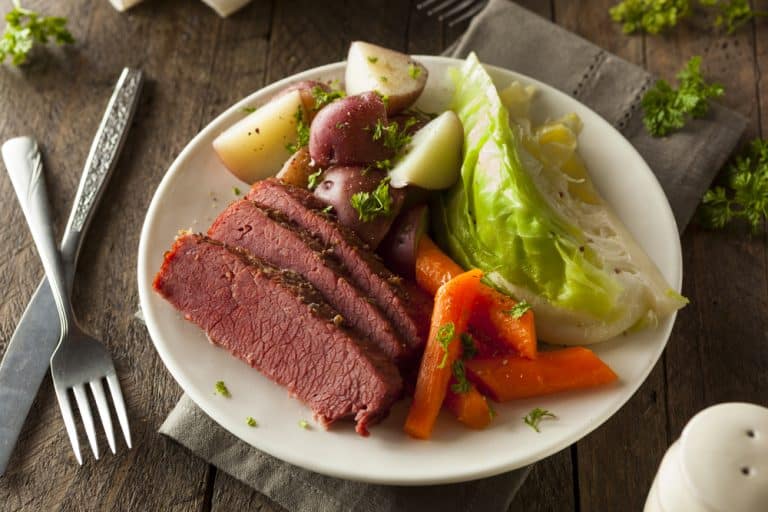Welcome to our guide on how to cook the best corned beef. Corned beef is a classic Irish-American dish perfect for St. Patrick’s Day or any time of year. It’s made from beef brisket cured in salt and spice brine, giving it a unique and savory flavor.
Cooking a corned beef and cabbage recipe can be intimidating, but it’s simple. In this article, we’ll walk you through the steps of how to make recipes to perfection, whether you’re using a slow cooker, stovetop or oven. We’ll also provide tips on selecting the best meat cut, preparing and serving it.
So, whether you’re an experienced cook looking to perfect your corned beef recipe or a beginner looking to try it for the first time, this guide has everything you need to know to make the best corned beef brisket that’s tender, flavorful and delicious. So, grab your apron and let’s get started![/vc_column_text][/vc_column][vc_column][vc_single_ =”7209″ img_size=”full” _hovers=”false” el_class=”section–header”][vc_column_text]
And while brisket can take a much higher temperature than a steak can, it too can be overcooked. If all the collagen turns to gelatin, that’s good, but if all the gelatin cooks out of the corned beef, you’ll just have a crumbly, dried out piece of salted beef.

Types of Cuts of Corned Beef
Corned beef is a classic dish made using the brisket cut of beef, which is considered the best cut for making your dish. Brisket is a tough and flavorful cut from the cow’s breast or lower chest. It’s a heavily exercised muscle, which gives it a lot of flavor but makes it tough. However, with proper preparation, brisket can become incredibly tender and juicy, resulting in the best meat.
To make corned beef, the brisket is brined or cured in a mixture of water, salt, sugar and spices for several days to several weeks. This process infuses the meat with flavor and tenderizes it, resulting in tender meat. Once the brining process is complete, the cured corned beef brisket can be cooked using a variety of methods, such as boiling, slow cooking, baking or pan-frying, to create delicious and flavorful dishes.
While brisket is the traditional cut of beef for making corned beef and cabbage, other cuts, such as beef round, can also be used. However, it is important to note that round tends to be less flavorful and more prone to drying out than brisket, so it may require extra attention during cooking to achieve tender corned beef.
The flat cut is the most common cut of corned beef. It’s a leaner cut from the bottom of the brisket and has a flat, rectangular shape. Flat cut corned beef is excellent for slicing and is often used in sandwiches or for serving as a main dish.
The point cut is a thicker, fattier cut from the brisket’s upper part. It has a triangular shape and is often more tender and flavorful than the flat cut. Point cut corned beef is excellent for slow cooking or braising and can be used in dishes like stews or casseroles.
While brisket is the traditional cut of beef used for corned beef, some people prefer to use round instead. Round is a leaner cut from the cow’s hind leg and is often less flavorful than brisket. Round cut corned beef is best used in dishes that will be sliced thinly, such as sandwiches.
In general, it’s best to stick with brisket when making corned beef and cabbage, as it’s the most traditional and time-tested option. However, if you prefer a leaner cut of meat, you can experiment with other cuts and see how they turn out. Remember that leaner cuts may require more attention during cooking to prevent them from drying out. The key to delicious corned beef is the brining process and the correct cooking method.[/vc_column_text][/vc_column][vc_column][vc_single_ =”7211″ img_size=”full” _hovers=”false” el_class=”section–header”][vc_column_text]
St. Patrick’s Day is just around the corner! To celebrate the holiday, we suggest the iconic Irish-American classic of corned beef and cabbage. Not only is this meal a delicious way to celebrate the Irish-American holiday, but making corned beef at home is also a satisfying cooking project! Whether you’re making corned beef for the first time or a cooking pro curious about how others make it, take a look at the list below of the five mistakes to avoid and what to do instead to ensure corned beef perfection.
Simmering corned beef on the stovetop is a tried-and-true method that results in very tender beef. One of the keys to simmering corned beef correctly is the amount of water in the pot. When there’s not ample liquid to cover the meat, your dreams of tender corned beef may be replaced by a tough, chewy result.
Instead: Cooking corned beef takes patience as it’s a tough cut of meat that benefits from a lengthy cook time. For stovetop cooking, plan on at least three hours for a three-pound corned beef or eight to 10 hours for a three- to four-pound cut that’s cooked on low in the crock pot.
Instead: Treat corned beef just like steak. Look for the lines of visible muscles fibers on the meat as this is the “grain” of the meat. Always sliced corned beef against the grain instead of slicing with it. Cutting through the muscle fibers shortens them and makes each piece easier to chew.
How to Make Corned Beef & Cabbage | You Can Cook That | Allrecipes
FAQ
Does corned beef get more tender the longer it is cooked?
How do you know if you overcook corned beef?
How long can you simmer corned beef?
Can you overcook slow cooked corned beef?
